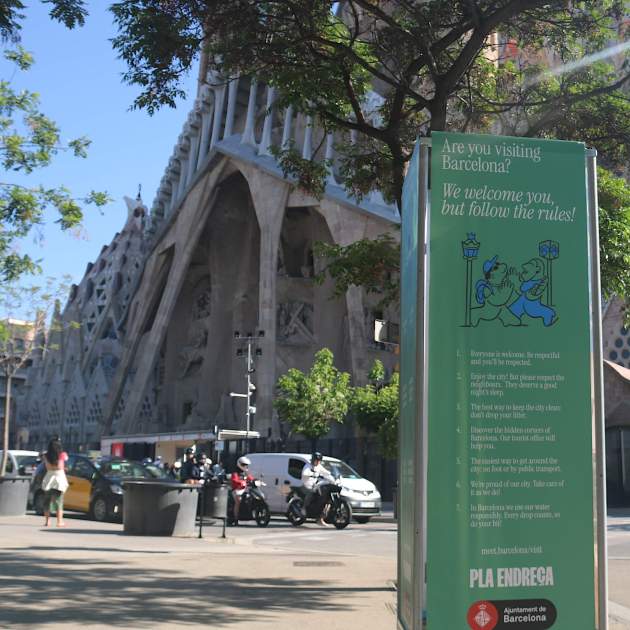The definition of sixteen areas within Barcelona as Espais de Gran Afluència (EGA) - that is, highly frequented spaces - and the start of actions in three of these areas, the Sagrada Família, Park Güell and La Boqueria, announced this Wednesday by Barcelona City Council, is accompanied by a new specific communication campaign aimed at tourists and which is already visible in the city this week. The main slogan - "Barcelona, our home. And yours" - takes as its starting point, as the deputy mayor responsible for tourism, Jordi Valls, underlined, "a position of defence for Barcelona as our city", the city where Barcelonans live, while at the same time affirming that "everyone is welcome as long as they are respectful".
Thus, the campaign subtitle: "Everyone is welcome. Be respectful and you'll be respected". With a budget of around 400,000 euros, the campaign will be seen in different formats and places around the city until the end of August, and it offers seven specific tips that aim to make visitors aware of the need to respect the rules. Thus, visitors are reminded that the locals "deserve a good night's sleep", they are told that Barcelona residents are proud of their city and thus ask visitors to "take care of the city as we do", and they are urged to use water responsibly. Valls has said that the campaign wanted to distance itself from the more "aggressive" messages used in some cities that have not had much impact. The Catalan capital's campaign, says Valls, wants to make it clear that tourists are visiting someone else's "home", and that they must respect the rules.
The campaign therefore wants to insist on the need for civic responsibility as well as zero tolerance of behaviour that is a nuisance for the neighbourhood, as well as to strengthen the projection of Barcelona to the rest of Spain and internationally as a reference point among 21st century cities. The campaign's messages will be visible in tourist information offices, city hotels, municipal markets, on buses and on cubes installed on public streets in some of those places "highly frequented" by tourists such as Plaça Catalunya, the Sagrada Família, the Sant Miquel beach at Barceloneta, the cruise ships terminal area in the Port of Barcelona or the Plaça dels Països Catalans, the large square outside the Sants rail station. Likewise, the image will be present in the baggage claim areas at the airport, train stations, the kiosks on the Rambla, on the screens in Metro trains and in other municipal media.
Additionally, outdoor banners and posters around the city will be used to spread the message further during the next two months, along with digital channels and media. And naturally, the digital option will mean that the campaign message is visible on the websites of, for example, tourist operators and visitors may be exposed to the campaign while they are preparing their trips. In other words, the plan is for messages to be visible in different places and at different times in the next two months to maximize their dissemination.
The right place at the right time
Likewise, the City Council plans to warn tourists not to go to certain areas at times when visitor numbers are excessively high and the experience is unlikely to be positive, and thus to avoid overcrowding and modulate the flow of people to the attractions with the most tourist appeal. Valls explained that the campaign will use tools that, through real-time data, can give instructions and suggestions to tourists to, for example, advise them not to visit the Mercat de la Boqueria when the crowds are at their densest, "because the experience for the visitor will not be positive".
Sixteen city spaces that are "highly frequented"
The City Council's definition of 16 spaces that are highly frequented is intended to establish a a new overall "governance" system for the places in Barcelona that suffer from "saturation of public space, transformation of uses, large volume of mobility and difficulty in developing community life". Of the 16 spaces, eight are very strong tourist magnets: Park Güell; Sagrada Familia; the Boqueria market and Plaça Gardunya; the Passeig de Gràcia-Plaça Catalunya area; the Gothic Quarter; the Rambla; the Sant Pere-Santa Caterina-la Ribera part of the old town; and Barceloneta. The other areas are: the Camp Nou stadium area; the Turó de la Rovira hilltop; the Glòries park and surroundings; the Rambla del Poble Nou axis; Parc del Fòrum festival venue; the beach front area; the Sant Antoni market and its area; and the mountain of Montjuïc and adjoining Poble Sec neighbourhood.
